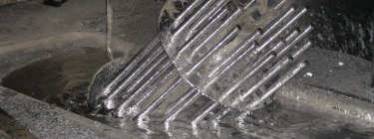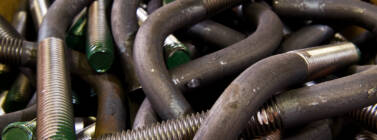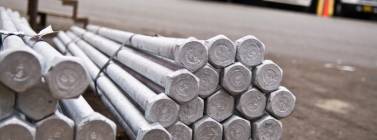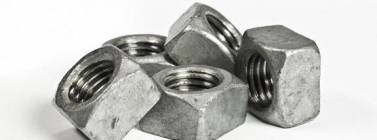Should nuts and washers be galvanized when used with galvanized bolts?
The short answer is yes. Here is why:
 When bolts go through the hot-dip galvanizing process the zinc leaves an extra layer coating the bolt. This extra layer of zinc adds 0.002” – 0.006” of thickness to the bolt. When galvanized nuts are manufactured their threads are tapped oversize to accommodate for the thicker material.
When bolts go through the hot-dip galvanizing process the zinc leaves an extra layer coating the bolt. This extra layer of zinc adds 0.002” – 0.006” of thickness to the bolt. When galvanized nuts are manufactured their threads are tapped oversize to accommodate for the thicker material.
If you were to try and pair a galvanized bolt with a plain nut you run into multiple issues such as:
- Threads – The female threads of a plain nut do not accommodate the slightly thicker threads of a galvanized bolt. This can lead to the nut not fitting on the bolt as well as running the risk of the nut stripping the threads of the zinc. This could leave those threads vulnerable to corrosive environments and lose the corrosion-resistant properties of the galvanizing process.
- Aesthetic Purposes– Galvanized bolts themselves are not particularly pretty. However, pairing them with a plain nut and washer would lead to a mismatch in colors and would not look nice.
- Corrosion Resistance – The main reason for procuring galvanized bolts instead of plain bolts is that galvanized bolts have properties that make them resistant to corrosion. This typically means they are used in corrosive environments such as marine environments and outside where they are exposed to the weather. Plain nuts and washers do not have the same resistance to corrosion as their galvanized counterparts. This means that the plain nuts and washers run the risk of rusting over time which could compromise their structural integrity. This also means that they do not have the same longevity as the galvanized bolts and will need to be replaced much sooner.
Galling
One of the most common grades of nut is the A563-DH. This nut has a requirement of being waxed and lubricated when provided galvanized. This is a requirement because the wax and lubrication help facilitate the nuts assembly onto the bolt. This also helps reduce the risk of galling.
Galling is when the nut essentially gets stuck on the threads of the bolt during assembly. This can occur for many reasons including faulty threads or using a plain nut with a galvanized bolt. Galling most commonly occurs with galvanized bolts because the zinc coating on the galvanized bolts makes the surface of the bolt not uniform or “bumpy”.
If you pair a plain washer with a galvanized bolt, you run into similar issues. Since washers are not being threaded onto the bolt you don’t run into issues with stripping the threads. However, there are still issues such as:
- Aesthetic Purposes – As stated previously pairing plain accessories with a galvanized bolt will not be aesthetic.
- Corrosion Resistance – Plain washers do not have the same resistance to corrosive environments as their galvanized counterparts or galvanized bolts. This means the washers would need to be replaced much sooner than the bolt itself. This could also mean that they run the risk of compromising their structural integrity. Of course, this is only an issue when they are being used in corrosive environments, but the most common reason for procuring galvanized bolts is so they can be used in corrosive environments.
Substitutions
A common workaround to using galvanized material is using stainless steel. Stainless steel has similar corrosion resistance properties. It is also commonly used in corrosive environments such as marinas, around chemicals, and outside exposed to the elements.
Something to keep in mind about stainless steel is the grades for this material have different strength requirements and mechanical properties. Stainless steel is often not as high strength as some of the grades of carbon steel.
Galvanizing
The process of galvanizing a bolt has multiple steps. Galvanizing itself is done to add a zinc coating to the bolt that adds corrosion-resistant properties. This is done by putting the bolts into an 840-degree tank of molten zinc for a pre-determined amount of time. The bolts are then removed from the zinc and spun in a centrifuge at high speeds to remove the excess zinc. After the bolts have cooled the threads are inspected and may require additional brushing to ensure there is no excess zinc that will prohibit proper mating between the nut and bolt.
Hot-dip-galvanizing is unique in the way that this process metallurgically bonds the zinc to the steel and is not just a coating on the outside of the bolt. Before galvanizing the bolts, they must go through a preparation process to ensure the zinc properly bonds to the bolts. This process includes wheelabrating high-strength bolts that contain any heat-treating scale. After the scale is removed, they are then submerged in caustic soda to dissolve any oils or dirt that may be on the surface of the bolt. The final step is that the bolts are then submerged in sulfuric acid. This is done to etch the surface of the bolts to help the zinc fully attach to the bolts themselves.
If you are looking for galvanized bolts, give Portland Bolt a call, email us, or chat and we will be able to help you out. And check out more about our proprietary galvanizing process.




Can A325 galvanized bolts be used in slip-critical connection?
@Boro- We are not aware of any restrictions in using galvanized A325 bolts in slip critical connections.
Hi, is shear and tensile capacity of A325 galvanized bolts the same as regular A325 bolts?
@Boro- The mechanical properties of plain and galvanized A325s are identical.